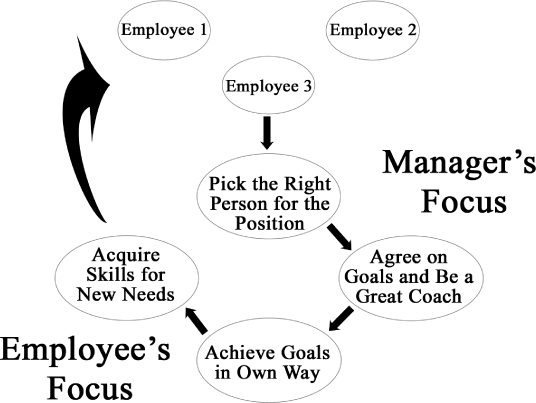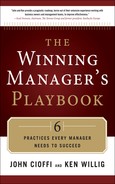Find the right person
Finding the right person is the most difficult of the three activities here. Virtually every business has hired a “terrific new employee” only to later discharge “a terrible employee.” Some business owners have even resigned themselves to the notion that the entire interview process is little more than a crap shoot—you do your best and then fire the ones that don’t work out.
There are, of course, numerous methods and processes for identifying and interviewing candidates. In fact, there are many companies that have been founded for the sole purpose of assisting business owners in the hiring of good employees. They practice their craft through books, on-line surveys and questionnaires, and in-person interviews and coaching.
We encourage you to talk with colleagues to identify any of these firms that have proven themselves. And we encourage you to work with the best of these firms to assist you in finding great employees. You’ll need all the help you can get, because this is anything but a science.
Our own experience has proven that there is at least one significant thing we can do to increase our ability to find the right person for a position. We need to determine if their natural abilities are well suited to the position we seek to fill.
Remember that list of natural abilities that we told you to include on your internal version of the Position Description? This is where it comes into play. For example, you might seek someone who loves working with numbers, or who loves meeting and engaging new people, or who loves creating new strategies when conditions change. Now the challenge is to find candidates that possess those natural abilities.
This is, unfortunately, not a straightforward task. If you ask a candidate if they possess these abilities, they likely will put on their “great interviewee” hat and tell you that they do. Consequently, you need to find a non-obvious means of identifying these individuals.
You can see that this process was not entirely logical. We tried to devise questions or situations to which there were not easily-discernable answers. We tried to get the candidates to reveal their natural abilities without asking them directly.
This client experience is described more fully in Appendix C. In that section we’ve provided you with detailed guidance on the process of actually creating the questions that are focused on specific natural abilities.
It’s important to realize that a natural ability that might serve us well in one environment might be a real liability in another environment. We shouldn’t think of these abilities as inherently good or bad. Instead, we need to look at the suitability of these natural abilities for a particular position or environment.
As an example, let’s go back and pick on that great engineer again. His love for details allows, indeed compels, him to be successful in his current environment. We’d be hard pressed to find a better person for the position. But what if the position were different?
Let’s imagine that because of his excellence at his current position, the engineer’s boss decides to promote him to become the Manager of Engineering. The boss might do this for a variety of reasons: put the engineer in a position where he can directly influence other engineers, reward him for a job well done, justify a higher salary with a commensurate title, set a great example, and so forth.
Sometimes, this actually works. People are promoted to a managerial position because they’ve excelled at their current position, and they turn out to be great managers.
Many times, however, it simply does not work. And when that Manager of Engineering doesn’t live up to expectations (“Just what is he thinking?”), his supervisors rely on negative feedback and discipline to remedy the situation: continually pointing out mistakes, providing plenty of negative signals, and writing a poor performance review.
So what happened? Why didn’t this guy perform as expected?
The reason is that the natural abilities required to be a great manager are significantly different than the natural abilities to be a great engineer. In fact, we believe that these differences are as great as if the engineer changed careers. Which is exactly what he did!
Being a great engineering manager is an entirely different career from being a great engineer. And the natural abilities that compel someone to succeed as a manager are different than the abilities that compel that person to succeed as an engineer.
This scenario is a common one—played out across businesses every day. So, is it wrong to promote people to management after they’ve done a good job in their position? It’s not wrong at all, as long as you’ve determined that the person has the abilities needed to be a great manager.
For example, you might determine that the managerial position you seek to fill requires strong coaching skills (among other things). If your crack engineer is a great coach (he loves to coach and does it well), he might be a strong candidate for the manager’s position (assuming he has the other abilities you seek). If he’s disdainful of being a coach, and merely expects everyone to “listen to what I tell them and then do a good job, that’s what we pay them to do,” you likely will do well to keep him away from your management ranks.
The vital need is to hire those with the right abilities for each of the positions in your company. You shouldn’t “just get a warm body in here” or “just get someone who can do the basics” if you intend to create a great company.
Remember: Those who possess the “wrong” abilities for a position may be perfectly suited for some other position. It may be another position in your company, or it may be in a company other than yours. Coaching these individuals in the “wrong” position may produce some small improvements, but these individuals will most likely never attain the high level of performance that comes naturally to those with the right abilities.
This company missed a great opportunity. They could have placed this talented individual in a role that would have played to her natural abilities—a role in which she would have thrived and excelled. She would have come to work every day energized and excited, and the company would have received these benefits without having to lift a finger. (How many times have you heard folks anguishing about how to improve morale or motivate employees?)
In the end, of course, the managers were required to replace her anyway. She made the decision for them. They lost an exceptional individual, and they spent much unneeded time filling her now-vacated position.
Most interestingly to us, stories like this are common, although not always quite as obvious. The challenge for great managers, and the one that these managers failed, is to identify the natural abilities of their team members and to place them in positions where they can use those abilities on a regular basis.
The search for people with the right abilities is a key responsibility of the manager, while the actual execution of the work required for the position is the key focus of the employee. As shown in the following illustration, both the manager and the employee are involved every step of the way, but the manager’s role moves from director to coach once the goals are established.

Early on, the manager’s primary focus is to define the position and then seek to fill the position from the available pool of candidates. Then the manager chooses the right person and clearly communicates the goals of the position to that new employee.
After this point, the employee’s primary focus is to execute the work required for the position and to acquire new skills, if possible, to adjust to changing needs. While the employee likely will not attain any new natural abilities, she can acquire new skills to improve her chances of attaining some new position within the firm.
It is during these later activities that the manager’s role focuses on coaching. Now that the manager has chosen the right person and clearly communicated the goals for the position, the manager coaches the employee to attain those goals and to acquire new skills.
The previous diagram might imply that hiring a new person into the company is the preferred solution. This may not always be the case, especially when the company has someone in a position that is particularly difficult to fill.
